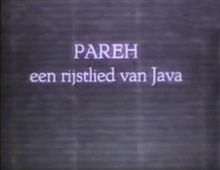Pareh
| Pareh | |
|---|---|

Title card
|
|
| Directed by | |
| Produced by | Albert Balink |
| Screenplay by |
|
| Starring |
|
| Music by | Paul Schram |
| Cinematography |
|
|
Production
company |
|
|
Release date
|
|
|
Running time
|
92 minutes |
| Country | Dutch East Indies |
| Budget | 75,000 gulden |
Pareh (Sundanese for "rice"), released internationally as Pareh, Song of the Rice, is a 1936 film from the Dutch East Indies (modern day Indonesia). Directed by the Dutchmen Albert Balink and Mannus Franken, it featured an amateur native cast and starred Raden Mochtar and Soekarsih. The story follows the forbidden love between a fisherman and a farmer's daughter.
Balink began work on the film in 1934, working with the Wong brothers, who served as cinematographers. They gathered a budget of 75,000 gulden – several times the budget of other local productions – and brought Franken from the Netherlands to assist in production. The film was edited in the Netherlands after being shot in the Indies. The film was a commercial and critical success with European audiences, but disliked by native ones; despite this success, Pareh bankrupted its producers.
Pareh resulted in a change in the cinema of Dutch East Indies, which had been Chinese-oriented for several years; films began to make more effort at targeting local audiences. Balink later found commercial success with Terang Boelan (1937). The American visual anthropologist Karl G. Heider considers Pareh and Terang Boelan the two most important cinematic works from the Dutch East Indies during the 1930s.
Mahmud (Rd. Mochtar), a fisherman, is in love with Wagini (Soekarsih), a farmer's daughter. However, local superstition dictates that their relationship will bring disaster. This seems to prove true after the village leader's keris is stolen, but eventually Mahmud and Wagini are able to unite with the help of his fellow villagers.
During 1934 and early 1935, all feature films released in the Dutch East Indies had been produced by The Teng Chun, based on Chinese mythology or martial arts, and targeted at low-class audiences, generally ethnic Chinese. This situation was created by the Great Depression, which had led to the Dutch East Indies government collecting higher taxes, advertisers asking for more money, and cinemas selling tickets at lower prices; this ensured that there was a very low profit margin for local films. During this period cinemas in the country mainly showed Hollywood productions.
...
Wikipedia
